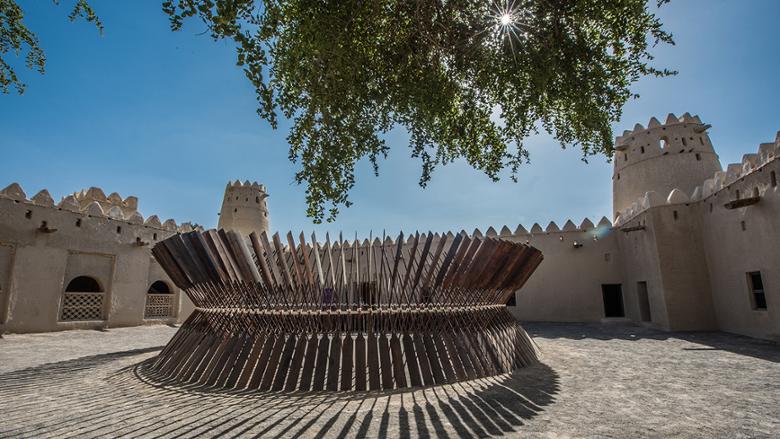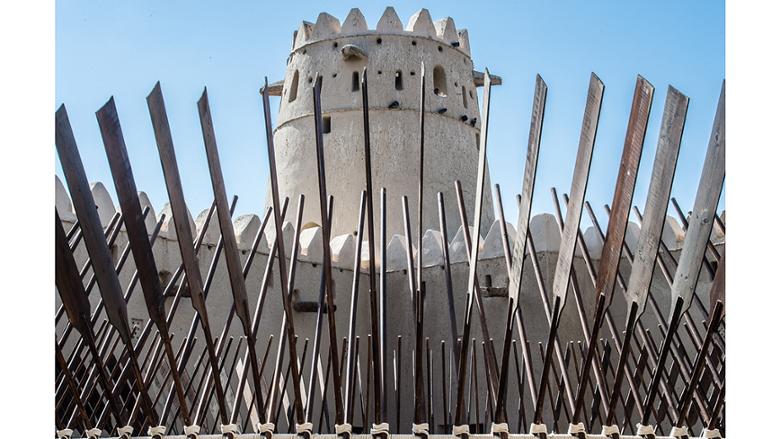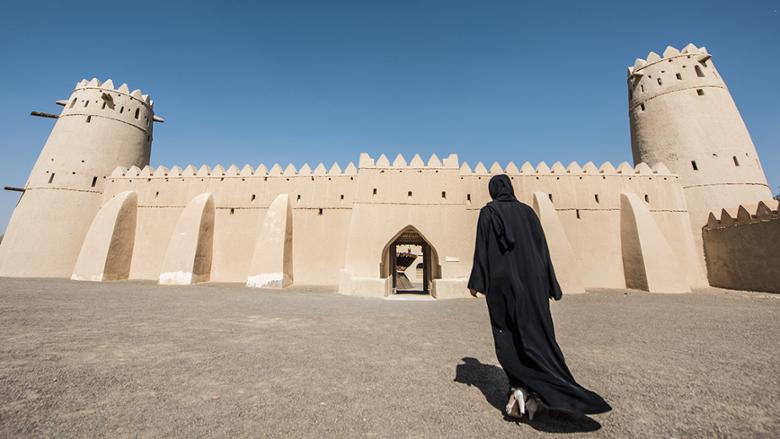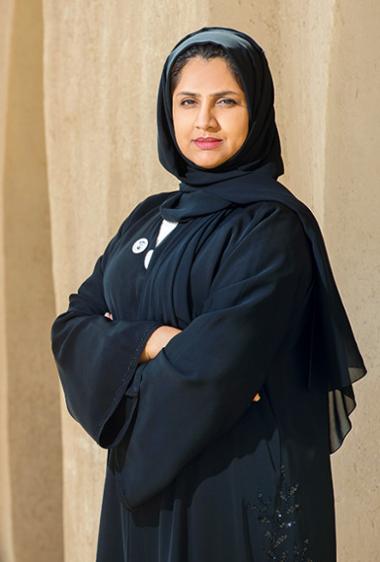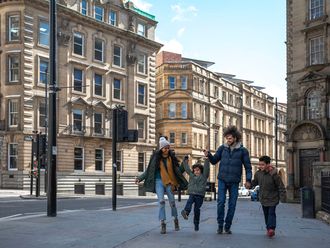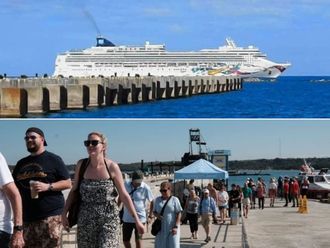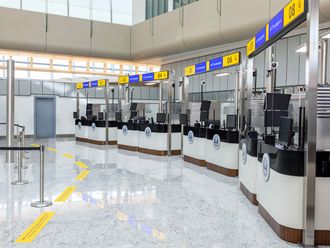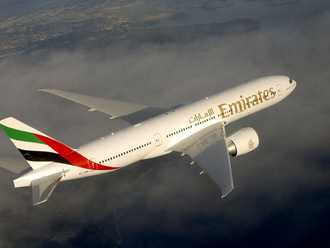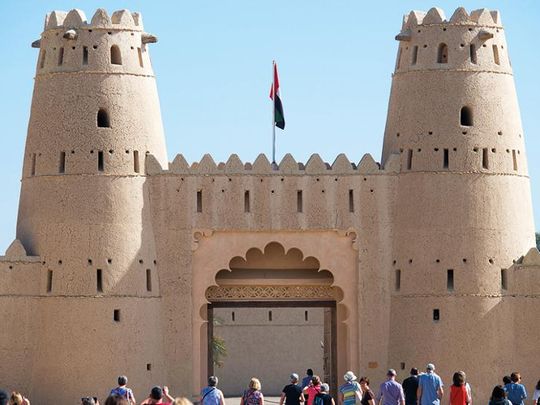
Perhaps no monument is as symbolic of the history of the UAE and so deeply entrenched with the lives of the ruling Al Nahyan family as the century-old, sun-dried mud brick Al Jahili Fort in Al Ain. One of the UAE’s most iconic historical monuments, it served both as a royal summer residence and a symbol of power. And just how much its distinctive four-storey circular tower reflects the nation’s pride, history and culture is evident from its presence on the back of the UAE’s Dh50 banknote — a picture that predates the renovation and restoration work undertaken by the Abu Dhabi Authority for Culture and Heritage in the 1980s.
On a bright sunny morning, following a 90-minute drive from Dubai, as we walk towards the imposing entrance of this magnificent fortified structure, we are joined by a bus-load of tourists who click away at the stunning façade of its monumental multi-foil arched entrance, flanked by two large round towers. We enter into a wide, open courtyard surrounded on all sides by sand-coloured walls and towers and are greeted by the delightful chirping of birds resting in the boughs of the towering trees. It is here at the Visitor’s Centre that we meet Huda Salem Al Musaabi of the Department of Culture & Tourism, who proceeds to take us on a guided tour of the Fort; and offers us a glimpse into its illustrious history.
Over a welcoming cup of Arabic coffee and bowl of dates, Huda explains how the more temperate weather of Al Ain — a lush green oasis, with an array of palm groves and natural springs — prompted Shaikh Zayed the First (Zayed Bin Khalifa Al Nahyan, 1836-1909), leader of the Bani Yas tribe and grandfather of the UAE’s founder, Shaikh Zayed Bin Sultan Al Nahyan, to build a summer residence here. ‘Low humid conditions in Al Ain, and the presence of fresh water and fertile land, was seen as a welcome respite from the intense heat and humidity of the coast of Abu Dhabi especially in the peak summer period lasting from June to September,’ she says.

The strategic location of the Al Jahili Fort, overlooking the Al Ain Oasis, also had a dual purpose of defending the city and protecting its extensive palm grove plantations while also maintaining inter-tribal peace, she explains. ‘The Fort also helped protect and safeguard its main water resource — the falaj, an underground water system that irrigated the surrounding oases. Several hundred families lived here, tending to their domestic herd and taking care of the vegetation.’
Restoration work undertaken here in recent times have led to the discovery of a falaj system running under the Fort into the nearby oases, she reveals.
Although construction of the fort, built in the Islamic military style, commenced in 1891, it wasn’t completed until seven years later in 1898. ‘It is believed that a watch tower was already in existence — to safeguard the falaj systems and oases from potential threats — even before the construction of the Fort began,’ she says. ‘Originally a two-tiered structure, two more layers of consecutively rising and narrowing concentric tiers were added to this tower as the Fort changed hands over the years.’

We enter the courtyard, and Huda points out that one of the dominant features of the Fort is the square, walled structure that features crenellations for rifle openings signalling its purpose as a defense fortification. “The other highlight here are the circular towers in three of its corners, while the tower in the fourth corner features a majlis in its upper tier. This is the reception area where the ruler conducted his daily official matters and met with citizens and visitors daily.’
The style of fortifications incorporating traditional architectural elements is similar to that of the third millennium BCE — as is evident from discoveries made at the Hili archaeological site in Al Ain, she adds.
We walk across the courtyard to the gate in the southern wall, which was originally the main entrance of the old Fort. Here, above the carved double wooden door, hangs a commemorative plate stating its date of completion — Islamic year 1316, 1898, and a short verse in praise of Shaikh Zayed the First is inscribed in spectacular Arabic calligraphy.
‘A door of goodness opens in this glorious chapter, Where joy and happiness reside. The blessings of honour said, “Mark this house, A house of high standing built by Zayed bin Khalifa.”’
Entering the arched doorway, we step into another courtyard — a traditional design element that enhances air flow and thermal comfort inside the structure. Here, occupying pride of place is a magnificent installation featuring 308 bread paddles — almost identical to wooden oars — and tied to each other in a circular shape to illustrate the themes of the endless migration of humans and the circle of life. ‘Following its restoration a decade ago, Al Jahili Fort has now positioned itself as a bastion of culture and heritage,’ says Huda, explaining the presence of the art installation.
Titled Sun Boats, Egyptian artist Moataz Nasr’s work is approximately 10 metres in diameter and 3.5 metres in height and is inspired by mankind’s constant state of motion, an infinite circle and visually depicts the endless, interconnected movement of human beings on earth seeking a better life.
Light and shade combine forces to cast mesmerising patterns on the ground — both of the installation and the crenellated walkways — and as the rays keep shifting, so does the imagery below our feet. This interplay of light and shade also casts its spell in the passageways featuring delicate mashrabiyas, a traditional Islamic window element with its characteristic latticework that not only offers protection against the sunlight but also privacy for its occupants.
Huda leads us to an old well — now unused — that once supplied water to the ruling family and those who dwelled in the nearby oases. We walk through the various rooms used by the royal household — there are 11 in all, and also notice a small tandoor oven that probably was used in later years by army troops.
The Fort, says Huda, fell into disrepair in the decades following the death of Shaikh Zayed the First in 1909. ‘His son, Shaikh Khalifa — the grandfather of the current UAE President — lived here for a while but eventually, the fort was abandoned. Not much is known of what happened in the years that followed.’
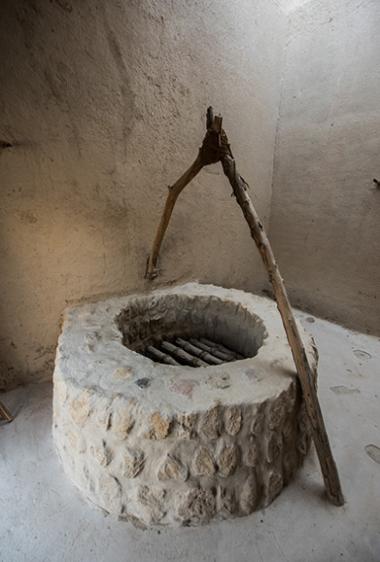
It is when the British forces came to Al Ain in the 1950s that the Fort once again began to be occupied, this time as an army base for the Trucial Scouts. ‘During this period, several restoration works were undertaken, including the building of the rectangular defense wall to create the large courtyard,’ she explains. ‘Service buildings and barracks were also built. Although the Fort remained an army training base until the 1970s, local communities also benefited from medical and other services that were provided here.’
Following the formation of the UAE in 1971, it was a decade later in the 1980s that the government of Abu Dhabi undertook the first major restoration work on the Fort and soon the vast courtyard became a fitting locale for cultural events.
But it was the second major restoration programme undertaken in 2007-08 under the supervision of the Department of Culture and Heritage — Abu Dhabi (Adach) that saw the Fort and the mosque attached to it take its final form and appearance as it is today, she adds.
With meticulous planning and using a combination of traditional materials and modern technologies, specialists followed the existing historical pattern of the Fort’s grounds and evidence from archaeology and historic photographs while creating its architectural design. Thus, mud blocks, straw, palm logs and leaves, and even reclaimed building materials from the Fort were combined with an innovative system of embedding cold water pipes into the mud plaster of the walls to restore the fabric and value of the building and maintain its sustainable character.
‘The existing thermal qualities of the traditional mud brick architecture was enhanced with the presence of chilled water pipes to provide cooling that ensures the temperature inside the Fort remains a comfortable 22 degrees Celsius, negating the need for air-conditioning,’ explains Huda.
This ambitious refurbishment project raised the profile of earthen buildings to the architectural heritage of the UAE and in 2016, it won the coveted Terra award for Internal Design and Layout thanks to the exceptional technical standards adopted for its restoration.
‘The Fort was opened to the public in December 2008 and today houses a permanent museum and exhibition centre, a space for temporary exhibitions, and a book store run by the Department of Culture & Tourism Abu Dhabi,’ says Huda. ‘One of our top sellers here is Words of a Leader that contains quotes of the late Shaikh Zayed, and which is available in five languages — Arabic, English, French, German and Spanish.’
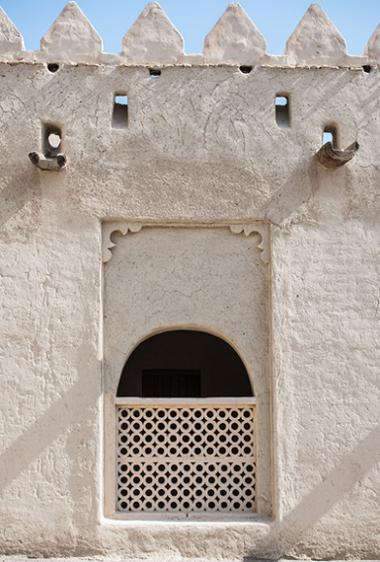
Huda leads us to the north end of the Fort complex to explore the permanent photography exhibition dedicated to the British explorer and intrepid traveller Sir Wilfred Thesiger, titled Shaikh Mubarak Bin London. ‘Mubarak, which means “Chosen by Allah”, was the name given to Thesiger by local residents when he first visited the area in the 1940s as they could barely pronounce his name,’ she explains. ‘This name also kept him safe from rival tribes who would have perhaps harmed him if they discovered he was English. What endeared him to the people is that he accepted the Bedouin way of life, lived in the traditional style, adopted their food and clothing habits and even spoke their language.’
Mubarak’s sojourns into the inhospitable Empty Quarter with his young Bedu guides, Salem Bin Kabina and Salem Bin Ghabaisha, are chronicled at the exhibition. His link to Al Ain stems from the friendship he strikes with the late Shaikh Zayed Bin Sultan Al Nahyan, whom he met after his second crossing of the Empty Quarter in 1948. ‘During his short stay in Al Ain, he went hunting, riding and attending daily gatherings with Shaikh Zayed who was then the Ruler’s representative in the eastern region,” explains Huda. “They formed a close bond that was to last a lifetime.”
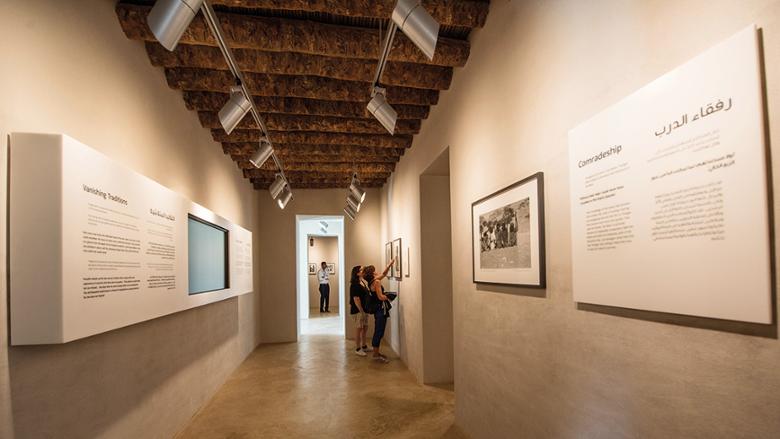
The series of black-and-white photos taken by Sir Thesiger during his five years exploring the Arabian Peninsula also includes an image of the Al Jahili Fort surrounded by sand dunes and ghaf trees. His images have beautifully captured for posterity, life of the pre-oil era in the region and his descriptions of the harsh life in the desert are poignant memories of a not-so-distant past — and it is easy to see why he called this period ‘the five happiest years of my life’.
Know before you go
Open daily 9am to 5pm, except Mondays. Fridays 3pm to 5pm. Location Al Mutawaa area, near Al Jahili Park.




